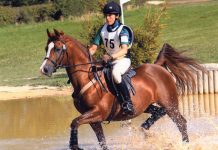In this issue, we will talk about how we can set our horses on the road to work. There are no wrong and right ways to do so, and it often depends on the sort of job you want your horse to do as to how to train him. We will take a look at a few different approaches, exploring possible advantages and disadvantages of some well-documented techniques. Sometimes we can use a varied mixture of methods, and at other times we can select specifically what we feel is appropriate at that particular time, for that particular horse.
In the last article, we got as far as getting the horse used to tack and the ‘work area’ in which they learn the routine and start to understand what is expected when working in-hand. So it is now time to move on, and we start with some mounting block work in preparation for backing.
Firstly, although some people think that a stable or similarly small and enclosed area may be ideal for leaning over and/or jumping on your horse in the early days, it is not always the case. Safety is paramount and, should the horse panic, he could smash your legs against the wall, buck, or rear all inside the stable. You and/or your assistant could be seriously injured and your horse would be traumatised. His instinctive reaction to fear is to run and, when enclosed in a stable, he may actually feel even more threatened. For this reason, I believe it is better to begin our backing procedure in our ‘work area’, that is, a nice, reassuringly open space.
Begin by getting the horse to stand still next to the mounting block – the larger, taller blocks are best for backing. The best way to do this is to incorporate it into your work with the horse fully tacked up and with a pressure halter over the bridle as explained in the last article. Always wear a hard hat that is up to safety standards, gloves, and suitable footwear.
If you are having difficulty getting your horse to stand calmly at the mounting block, use gentle pressure on the halter to halt, back up, and turn, releasing the pressure and rewarding your horse whenever he does stand still. Try to avoid giving treats to bribe your horse as this can make them bite or expect it every time, and that in itself can create problems. Instead, in order to make the mounting block experience a pleasant one, try ‘grooming’ him with your knuckles around the wither area, just like another horse would, when he stands still. Some horses enjoy this too much and want to groom you back, so be aware! Creating this positive association is a great way to relax your horse during the backing process. Mix the mounting block work into your other work during the session.
Once the mounting block work has begun and it has become part of your horse’s routine, where he relaxes and stands still every time, then you know you are ready to begin placing your weight over. If he is fidgeting and looking tense with ears pinned back, there is no point in attempting anything more. He is likely to react in a way that will scare him, and possibly you, and he will have a bad experience.
Don’t run before you can walk and everything will go smoothly!
Below we discuss groundwork techniques that can be done on an on-going basis alongside ridden work and as a preparation for ridden work. This is not an exhaustive list, but rather a selection of the most popular or commonly seen methods. It is not our intention to persuade or dissuade anybody from using these techniques, but to give a very brief overview in order to allow you to make your own choices. Also, a combination of techniques and methods can be used. The advantages and disadvantages listed are only a very brief insight and may not include every consideration.
Choosing the right method or methods can depend upon what job your horse is going to do and your horse’s personality.
For example, if you want to end up with a calm horse on which you can gain confidence and take things slowly, then doing lots of walking exercises at first will help, rather than shooing him away around the school, loose schooling.
Join up
Join up is a process that is usually conducted in a round pen with a loose horse. It is known as a ‘natural horsemanship technique’. It involves chasing the horse away until he doesn’t want to do so anymore and begins to follow you. This is exactly what happens within an established herd of horses when a new comer is introduced. The horses chase the new horse away at first until he is accepted and the pecking order is established.
Advantages: It can be a great way to form a bond with your horse and establish leadership. It only needs to be done once, and when it has been successful you don’t need to keep repeating it.
Disadvantages: Some horses get scared and gallop around, which can cause injury and undue strain. If done before lunging has been introduced, the horse can be confused and progress may be difficult. You have chased him out and away from you until he has chosen to follow you everywhere, and then you want him to lunge and stay out on the track.
Loose schooling
Loose schooling is self-explanatory. It is almost lunging without a lunge line, in an enclosed space such as an arena.
Advantages: Can be used to show the horse’s natural paces in a larger area.
The use of body language to train the horse and not having to worry about a lunge line getting tangled, especially when jumping and doing faster work.
Disadvantages: You need to be quite aware of, and in control of, your body language and quick to react. It is easy for the horse to suddenly turn around and go the opposite way, and then he has then taken leadership over you. You have less direct control, and should the horse get scared or too enthusiastic, damage to himself or your fencing may result.
Lunging
Lunging is traditionally carried out on a circle with a line, but also can be done on the straight, or moving around.
Advantages: Can be a controlled way to introduce and establish trot and canter. A great way to see your horse move on both reins.
Disadvantages: You need to practise the art of lunging, from how to hold your line safely, to using appropriate body language. It is not always an easy thing to teach a horse to do. It can be hard to establish straight lines.
Long reining
Long reining usually involves standing behind the horse with two lunge lines, or in some classical forms of training, working from the side of the horse.
Advantages: Great for accustoming the horse to a contact. Straight lines and turns can be established as well as lateral work. Straighter lines and slower work can put less stress on a young horse’s joints than lunging on smaller circles. Enabling the horse to develop its core strength and balance.
Disadvantages: You need to be well practised in terms of safely using your lunge lines and body language. Some horses are uncomfortable at first with someone standing behind and they can become tense. It can be a safety hazard if your horse bolted and you were behind.
In-hand/Pressure halter
In-hand work is what we touched on in the last issue, working fully tacked with a pressure halter on as well so that we don’t need to pull at the mouth. We can perform anything we could do when riding – turns, circles, poles, straight lines, lateral work, and transitions. Also, this teaches the horse to trot up.
There are various forms of classical training that are considered as in-hand or groundwork that require experience and skill. We will consider these quite remarkable methods in a future article, and so the advantages and disadvantages outlined below are not related to classical training.
Advantages: We can begin ridden work this way as the horse will remain calm and responsive for your assistant while he gets used to carrying your body weight.
This is a very safe and effective way of starting your horse.
Disadvantages: You have to eventually move away from this method when introducing more trot and canter. It is only really for the early parts of ridden training unless you are preparing a lead rein pony. You need an assistant.
You can use a combination of your preferred techniques that will be appropriate to the job your horse is going to do. We mustn’t forget desensitising and road work too. Sharing our secrets to success, Enhanced Riding will take you through the youngster-training journey, but of course, older horses and those in need of re-schooling can be worked in exactly the same way. Join us next time when we will look at each of our methods in more detail, and give you some great ideas to try each one for yourself. We will look in great detail at in-hand work and the first stages of backing, explaining the best approach to the first steps you take on your horse.
Find out more about Wendy Bliss, her experience, and work at www.clipandcanter.webs.com












